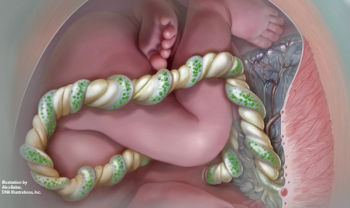
In a Swiss comparative trial, diclofenac was found to be inferior to norfloxacin for treatment of urinary tract infection (UTI).

In a Swiss comparative trial, diclofenac was found to be inferior to norfloxacin for treatment of urinary tract infection (UTI).

An analysis of data from the National Immunization Survey-Teen (NIS-TEEN) 2015 shows that parental concerns about human papillomavirus (HPV) vaccination are gender-specific.

Results of a randomized clinical trial (RCT) suggest that over-the-counter moisturizer may be just as effective as vaginal estrogen tablets for treatment of vulvovaginal symptoms (VVS) in postmenopausal women. Plus: Does a Mediterranean diet help protect bones in postmenopausal women? Also: Metformin, an oral diabetes medication, seems to reduce the likelihood of late miscarriage and premature birth in women with polycystic ovary syndrome (PCOS), according to results of a multicenter study.

Failure of liquid nitrogen storage tanks at two major infertility centers has led to a review of procedures at those and other similar facilities by them and the American Society for Reproductive Medicine (ASRM). Plus: Does MHT affect cardiovascular health? Also: Hirsutism treatment and diagnosis updated.

Women who smoke cigarettes may be more susceptible to urogenital infections and have more vaginal malodor, according to a cross-sectional study.

Allegations in this case include extended use of oxytocin and allowing labor to continue too long.

The aim of this paper is not to outline a specific medical-surgical algorithm for managing PPH, but rather to give an overview for system-wide preparedness that should be considered in planning to mitigate this frequent, potentially life-threatening, obstetrical emergency.

Planning up front for an endoscopic gynecologic surgical procedure is the best way to prevent an injury or complication.

Roughly one of two Ethiopian women were found to have bacterial vaginosis (BV) that strongly correlated with personal hygiene, according to a cross-sectional study.

Interim data from two studies of a dapivirine vaginal ring-DREAM and HOPE-lend further credence to the potential benefits of using the device for HIV prevention. Plus: FDA authorizes direct-to-consumer BRCA1/BRCA2 test. Also: A new Zika virus test extends window for accurate diagnosis.

A collection of standards, guidelines, tools and articles for the OB managing postpartum hemorrhage.

In the second part of Dr. Lockwood's editorial on opioids, he discusses steps that ob/gyns can take to help limit opioid use disorder in our pregnant and non-pregnant patients.

A newly published pilot study is the first to show that the selective estrogen receptor modulator (SERM) ospemifene effectively normalizes vestibular innervation sensitivity, in addition to confirming that it relieves postmenopausal vestibular signs and symptoms.

Dyspareunia is a common female health problem, according to a large British population probability survey, affecting 7.5% of sexually active women.

James Greenberg, MD, reviews the LaparoVue Visibility System, a single-use, disposable system designed to eliminate fogging while cleaning laparoscopes and trocars during a procedure.

Ob/gyns are on the front line of the opioid epidemic and have a responsibility to recognize, treat, refer, and advocate for pregnant women with opioid use disorder.

In large part, clinicians and patients do not see eye to eye when it comes to what they consider important criteria for a rating scale assessing female sexual desire, according to a literature review

According to a literature review, apart from the essential role that sex hormones play in modulating hypoactive sexual desire disorder (HSDD) through therapeutic interventions, a comprehensive understanding of the biologic mechanisms underlying the disorder is imperative.

According to research, the size of a woman’s hips and waist may be the best indicators of her risk of a heart attack. Plus: Adverse risks of pregnancy over 40. Also: Active surveillance of CIN2 is a viable treatment, according to a study.

In a new statement, the US Preventive Services Task Force (USPSTF) is recommending against ovarian cancer screening for women who have no symptoms and no hereditary cancer syndromes. Plus: Breast MRI screening results in higher biopsy rates, according to a study.

A lower-dose estradiol vaginal cream than is currently available in the United States was an effective and well-tolerated treatment for dyspareunia in postmenopausal women, according to a recent phase 3, randomized, multicenter, double-blind, placebo-controlled trial.

Higher levels of distress were linked to increased vaginal sexual symptoms, worry about dyspareunia, dissatisfaction with a relationship, and concerns about body image in a study looking at sexual well-being among cervical cancer survivors.

A 62-year-old woman presents for her annual gynecologic exam, stating that she has had a 4-month history of worsening vulvar pruritus. Can you make the correct diagnosis and treatment plan?

A drug that is low cost and easy to administer may help prevent maternal deaths, according to results of a randomized clinical trial. Plus: Does air pollution affect menstrual regularity? Also: According to a statement published by the American Heart Association (AHA), breast cancer patients may be at increased risk of cardiovascular disease (CVD).

Plaintiff alleged that excessive force from implementing the vacuum resulted in intracranial hemorrhage and subdural hematoma.

Expert commentary on Practice Bulletin No. 184: Vaginal Birth After Cesarean Delivery.

Our latest survey paints a picture of ob/gyns simultaneously dedicated to their profession and increasingly frustrated by external stressors.

To help combat maternal mortality rates globally, the US government has invested more than $15 billion since 2008 in innovative measures to accelerate reduction in deaths. These efforts are led by the US Agency for International Development (USAID).

Like the road to hell, the road to the opioid crisis was paved with good intentions.

With the United States ranked No. 50 globally in maternal deaths, support is growing in Congress for the Preventing Maternal Deaths Act of 2017 (H.R. 1318/S. 1112).